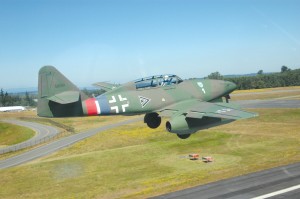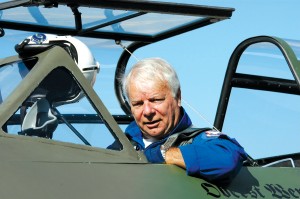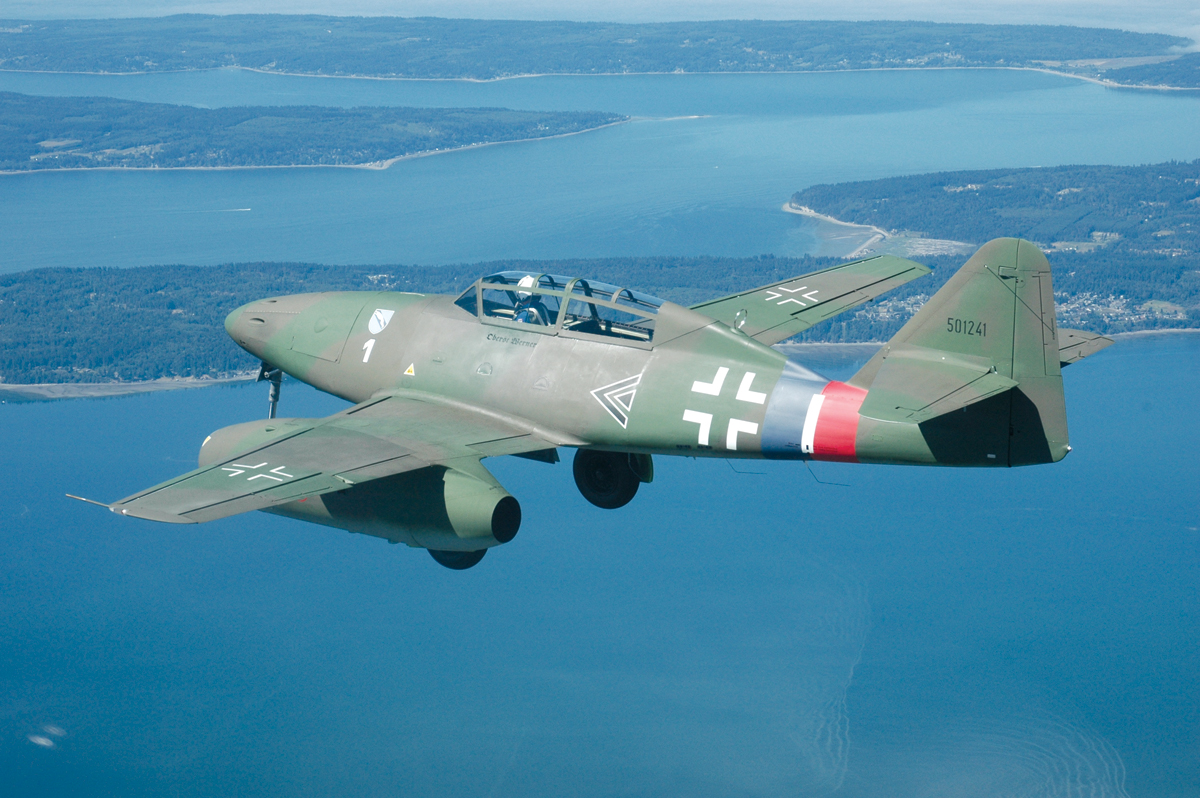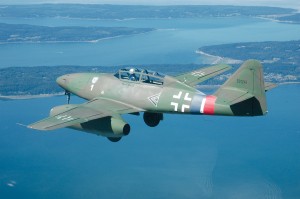|
By Terry Stephens
Wolfgang Czaia’s fascination with all things that fly goes back to his early childhood years in his hometown of Andernach, on the Rhine River. In 1944, during World War II, his home was destroyed during a bombing raid by the 8th Air Force. His family was evacuated to the Black Forest. U.S. fighter planes, banking through the narrow valley in search of targets, visited the little town on a regular basis. “I was in awe of these swift and noisy machines, and thought it would be a lot more fun and safer up there than down here on the ground,” he recalled. That awe led him to join Germany’s air force in the late 1950s. “After the initial screening program, they sent groups of flight students for jet training to various bases in the United States,” he said. Along the way to Selma, Ala., Czaia stopped in Houston for an aviators’ convention. There, he met a pilot with unexpected ties to his past. “As I was talking with an American colonel who had been in the war, he remembered being on bombing runs over my town on Dec. 26, 1944,” he said. “When I discovered I’d met one of the pilots who had bombed my home that night, I jokingly put my hands on his throat.” It was soon evident to Czaia and his instructors that he had chosen the right profession. As a pilot, he excelled in flying, graduating as the top T-38 student at Randolph Air Force Base in the USAF Instrument Pilot Instructor School and “Top Gun” and “Outstanding Student” at Luke AFB. Later, he became a military flight instructor in F-104s, training German, Dutch, Belgian and Italian NATO pilots at Fighter Weapons School 10 at Jever Air Base. |
Czaia has more than 27,000 hours of flight time. Since he began flying gliders as a high school youth in Germany, he’s progressed through a variety of aircraft, from the L-19, Dol-27, FW-149, T-6, T-37, T-33, T-38 and a Skyfox (a modified T-33), to a MiG-29, an Iskra Polish jet trainer and a Pilatus PT-9.

Wolfgang Czaia, flying a recreated, historic two-seat version of the famed Me 262, touches down at Paine Field after a scenic flight over Puget Sound.
In various roles as a civilian pilot, he’s flown Learjets, Boeing’s 737, 757 and 767, more than two dozen types of single-and multi-engine prop planes, helicopters and the prototype of an Avtek-400, designed as an all-composite, fanjet business aircraft. Overall, his logbooks include more than 100 types of aircraft.
Over the years, Czaia has been a flight instructor and chief pilot at a variety of FBOs in the U.S., as well as an instructor at the USAF Test Pilot School, Edwards AFB, and the International Test Pilots School in Cold Lake, Alberta, Canada. Along with roles as a check pilot and FAA designee on the 757 and 767, he’s been a Learjet chief pilot for National Jet and a 737 captain for Air California/American Airlines. He stayed with American Airlines until four years ago, when he was reluctantly squeezed out due to the airline’s mandatory retirement age of 60.
Today, he still flies as a contract pilot for a privately owned 757 airliner.
For the past 20 years, the resident of Clinton, Wash., on Whidbey Island, has served as test pilot for the Messerschmitt 262 project at Paine Field, in Everett, Wash. There, skilled craftsmen are building reproductions of the Me 262, the world’s first fully operational turbojet aircraft, which entered aerial battles with B-17s and P-51s near the end of World War II.
Czaia clearly loves to fly, and he’s happy in all cockpits. Of all of the planes he’s flown, however, the F-104 Starfighter stands out as his all-time favorite. He has very fond memories of the years he spent in the 1960s training German pilots at Jever. On Nov. 17, 1964, as a young first lieutenant in the Luftwaffe, he lifted off in an F-104 for the first time.
“I knew right away that was my airplane,” he said, adding that the Starfighter “is a handful.”
“It’s not the easiest or the most forgiving,” he said. “You fly it by the book. But there’s something about the F-104 that’s unique. It’s the only airplane in the world that has its own fan club.”

For the past 20 years, Wolfgang Czaia has served as test pilot for the Messerschmitt 262 project at Paine Field, in Everett, Wash.
He said German pilots training at Luke AFB initially formed the Cactus Starfighter Squadron. “Later, it included pilots of all the world’s air forces who had ever flown the airplane,” he said. Czaia praised Kelly Johnson’s design for the Lockheed fighter-bomber, which he says is a “sexy airplane.”
“A lot of airplanes seem to be designed by a committee,” he said, smiling and adding that a “camel, for instance, is said to be a horse designed by a committee.” “Johnson’s designs of the Super Constellation, the SR-71 and the F-104 have beautiful lines. In my opinion, if something is aesthetically beautiful, it usually functions beautifully, too.”
The F-104 didn’t function “beautifully” for every pilot, he admits. Germany received 915 Starfighters, 35 percent of all of the F-104s built. With them, they formed five wings of fighter-bombers, two interceptor wings and two reconnaissance wings, along with two attack wings assigned to the Federal German Navy.
The plane’s primary role was low-level missions in Europe. New F-104s were being delivered nearly every day, spurring a massive pilot training program. With Northern European weather and operating restrictions to contend with, few training hours were available. A Luftwaffe training operation was set up in this country at Luke AFB to take advantage of clear weather and nearly wide-open air space.
Tragically, when the pilots who had trained in clear skies over Arizona tried to fly in Europe’s stormy, low-visibility weather, often over mountainous terrain, the transition was disastrous. In 1961, the first year of intensive F-104G Luftwaffe operations, there were only two crashes. That number grew to seven the next year, then 12 in 1964, and 28 in 1965.
By the mid-1960s, Germany had lost 61 Starfighters and 35 pilots, earning press headlines that called the plane the “Widowmaker” and a “Flying Coffin.” During the aircraft’s years of service with the German armed forces, about 270 planes were lost, with 110 pilots killed. Czaia noted that most of the crashes that plagued the West German Luftwaffe involved pilot errors.
By comparison, the same foul weather had cost the Luftwaffe 36 percent of the F-104’s predecessor, the Republic F-84F Thunderstreak. Canada actually lost more than 50 percent of its 200 Starfighters in flying accidents, according to military records.
“The transition from the F-84 to the F-104 was a gigantic leap for pilots,” Czaia said. “Because of the complexity of the inertial navigation and other systems, maintenance was initially not able to provide the flight hours needed to keep pilots proficient.”
Czaia said that although the accident rate was initially high, it later dropped to a more normal level, and even below that in its later years in service.
During his 11 years with Germany’s air force, from 1959 to 1970, Czaia flew the F-104 for six years, all of them as an instructor, and never had problems with it, he said. In fact, throughout his life he found he couldn’t stay away from the plane.
In 1970, he left the air force to join Lockheed on its CL-1200 Lancer project, a modified derivative of the F-104 and a competitor to the F-5. Soon after arriving, however, Lockheed’s financial woes forced cancellation of the project.
Working as an airline pilot and flight instructor for years afterward, he came across an opportunity to help a small research and development company in Alabama put a CF-104D it had acquired from Norway’s air force back into service. Flight testing proceeded at Mojave, Calif., and Edwards AFB until the plane was sold to Thunderbird Aviation in Deer Valley, Calif. Czaia followed the plane to fly for Thunderbird but that operation shut down after only two years.
It turned out that wasn’t all bad news for Czaia. Rick Svetkoff, a Continental Airlines captain, bought the airplane and formed the Starfighter Aerial Demonstration Team with the late Tom Delashaw. Czaia initially served in a supporting role, but after Delashaw’s untimely death in a Hawker Hunter, he joined Svetkoff’s team fulltime. Performing at air shows in the U.S. and Canada, Svetkoff usually flew the two-seat “D” model Starfighter and Czaia the single-seat CF-104.
Exactly 40 years after Czaia first flew an F-104, on Nov. 17, 2004, a CF-104D with the Starfighter Aerial Demonstration Team took off from its home base in St. Petersburg, Fla. With Czaia at the controls, it ended 40 minutes of aerobatics with a supersonic dash over the Gulf of Mexico.
Czaia happily recalls that celebration flight, noting that the rear seat was occupied by Diana, his “life’s copilot.” He said she wasn’t even a little hesitant.
“Some people would be afraid of those speeds and maneuvers, but she loved it,” he said.
Czaia said that 40 years ago he would’ve never imagined that today he’d still be flying “this magnificent machine” on a regular basis.
“And I have no intention to hang up my spurs anytime soon,” he said.












